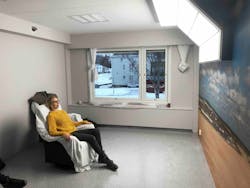A psychiatric hospital in Norway that installed spectrally-tunable lighting for bipolar patients is reporting positive results including slightly shorter stays, improved sleep, more upbeat self-assessments, and possible reductions in medication.
It has also extended the use of the lighting beyond an initial therapy room and into patients’ rooms and common areas to further help in treatment of the condition, characterized by periods of mania and depression.
Valen Hospital, south of Bergen on the west coast of Norway, started using a light therapy room as part of the emergency department in March 2019. The move was instigated by the department’s chief physician Tone Elise Gjøtterud Henriksen, a specialist in light therapy for bipolar disorders.
The tunable system, described as circadian lighting and provided by Denmark’s Chromaviso, allows doctors and psychiatrists to tune spectral content in a manner deemed suitable for each patient. For example, it can strip out the blue spectra, an action that Henriksen has shown in past controlled studies to reduce mania and improve sleep when applied in the evening.
“We have experienced a shorter hospital stay for those patients who use the light therapy room,” Henriksen said. “They are typically hospitalized one to two fewer days, out of the average hospital stay of seven to eight days.”
Patient feedback has been good, according to Henriksen. Not only do they report that they “feel better,” but they also note a positive perception from not relying solely on medication for their improvement.
“We offer it as an alternative or supplement to medication to all depressed patients,” Henriksen said. “Research shows that light therapy alone can be as effective as medication alone. If the two are combined, a double effect is achieved.”
Following the success of the therapy room, the hospital last October installed Chromaviso circadian lighting in patients’ rooms and in common areas including corridors. The Chromaviso system, called Chroma Zenit, generally delivers light throughout the day that mimics the wavelengths delivered by the sun — more blue-rich during the day and eliminating blues at night.
Doctors prescribe individual spectral content and doses based on the condition of each patient.
“Common to all patients is that they should have darkness at night and adequate light during the day,” Henriksen said. “But exactly how much light and darkness depends on the phase. In the manic phase, patients need fewer lighting hours and more darkness, while patients in the depressive phase need more lighting for a longer period of time.”
Some circadian lighting research findings shared by the Lighting Research Center at Rensselaer Polytechnic Institute have indicated that both spectral content and light level can influence responses from the human non-visual systems in an office setting — with the general idea that higher light levels alongside blue-rich wavelengths stimulate, while lower light levels with warmer-red output can calm. Varying combinations have been studied for different times of day in that commercial setting.
Henriksen is optimistic that the cyclical light therapy can to some extent replace medicines.
“The combination of lighting and medicine is good — and the need for medicine seems to be less when we use light and darkness instrumentally in the treatment,” she noted. “We can reduce the large doses of medication that patients receive over a long period of time. This is good because the medicine in this area has many side effects with potentially negative consequences for the general health of the patients.”
In an example from three years ago, a Chromaviso system did indeed reduce the need for medications at a psychiatric hospital in Denmark.
Circadian lighting, also known as human-centric lighting, is an emerging field for commercial settings, and is being used increasingly in healthcare settings, such as for dementia and for stroke patients.
The implementation at Valens Hospital is a practical deployment based on earlier findings in controlled studies by researchers including Henriksen, who has published in scientific journals including Bipolar Disorders and The Journal of Sleep Research. Italian specialist Francesco Benedetti also helped design the therapy room system. Benedetti is associated with Italy’s I.R.C.C.S. Ospedale San Raffaele.
Increase your enlightenment with these related articles
Human-centric lighting takes hold in the commercial workplace
Signify aims all-in-one artificial skylight, circadian luminaire, color system at office wellbeing
Human-centric lighting illuminates the possibilities for wellbeing
Danish care home looking at circadian lighting's potential to improve health of dementia residents
Hospital: Lighting helps stroke patients deal with fatigue, depression
MARK HALPER is a contributing editor for LEDs Magazine, and an energy, technology, and business journalist ([email protected]).
For up-to-the-minute LED and SSL updates, why not follow us on Twitter? You’ll find curated content and commentary, as well as information on industry events, webcasts, and surveys on our LinkedIn Company Page and our Facebook page.







